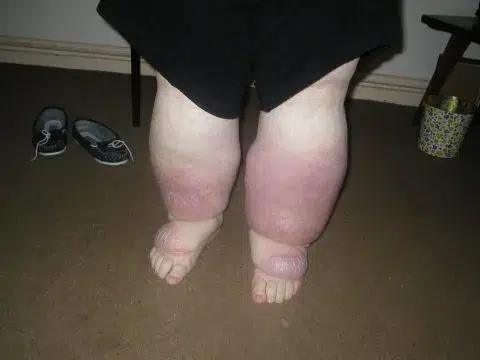Understanding Lymphoedema – Symptoms, Causes, and Treatment

Lymphoedema is a chronic, often progressive condition that involves swelling of the body, usually in the arms or legs, from damage or dysfunction of the lymphatic system. Though it can start subtly, if not addressed, lymphoedema may have a significant impact on your ability to get around, look after yourself, and your well-being.
This blog is designed to demystify lymphoedema by exploring the symptoms, causes, stages, and available treatments. Whether you are impacted yourself or know someone who is, early detection and appropriate medical attention can make a difference in your quality of life.
What is Lymphoedema?
Lymphoedema happens when the lymphatic system – which clears the body of excess liquid and also supports the immune system – does not work properly. The lymphatic vessels and nodes are part of the body’s immune system and help to filter out sicknesses and disease.
When these pathways are obstructed or impaired, lymph fluid accumulates in the body’s soft tissues, resulting in observable swelling and pain. There can be any number of reasons why the lymphatic system doesn’t work as it should, according to the NHS, and while there isn’t currently a cure, the condition can be controlled with the right treatment and care. NHS Lymphoedema
Lymphoedema Causes
Lymphoedema comes in two forms: primary and secondary. Knowing the aetiology is crucial for effective treatment.
Primary Lymphoedema can be due to a hereditary or developmental abnormality of the lymphatic system. One of them is Milroy’s disease, a rare genetic disorder which causes missing or undeveloped lymph nodes.
Secondary Lymphoedema is much more common and develops due to damage being caused to the lymphatic system. Causes include:
- Cancer Treatment: Surgery or radiation treatment for cancers (particularly breast, pelvic, or prostate) can damage or remove lymph nodes.
- Infections: Some parasitic infections, including filariasis (common in tropical regions), can block lymphatic vessels.
- Trauma or Injury: Surgical intervention, burns, or injury to lymphatic passages.
- Obesity or Venous Disease: Being overweight or having damaged veins puts pressure on lymph vessels.
Early identification of the cause may slow or stop progression of the condition.
Signs of Lymphoedema
Lymphoedema usually starts gradually. If you see any of the early symptoms below, you’ll definitely want to get a doctor’s opinion:
- Longstanding swelling in one or both extremities.
- Feeling heavy, full, or experiencing dull and aching pain in the region.
- Thickened skin or leathery texture.
- A history of repeat infections, with cellulitis being the commonest one.
- Trouble wearing clothing or shoes because of swelling.
Early intervention by either a lymphoedema therapist or specialist can avert such sequelae.
Lymphoedema Symptoms (Progression)
As lymphoedema advances, the symptoms can worsen:
Mild:
- Transient swelling that might clear with rest or elevation of limb.
- Discomfort or feeling of fullness.
Moderate:
- Bloating becomes chronic, a standing occurrence.
- The skin begins to alter in texture or colour.
Severe:
- Fibrosis, which is the hardening of tissue.
- Sometimes dramatic swelling of limbs (elephantiasis).
- Recurrent UTIs and limited physical mobility.
Physical comfort and quality of life are affected in each stage, and care should be preventive.
Lymphoedema Stages
There are generally considered to be 4 main clinical stages of lymphoedema:
Stage 0 (Latent):
- No swelling is evident, but lymph draining is subnormal.
- Early diagnosis at this point gives the greatest chance for recovery.
Stage 1 (Reversible):
- Soft pitting oedema reduces the elevation of the limb.
- The skin looks normal, and treatment is very successful.
Stage 2 (Spontaneously Irreversible):
- The swelling becomes more firm and does not subside easily.
- The skin is thick and fibrotic.
Stage 3 (Severe/Elephantiasis):
- Prominent swelling, thickening of the skin, and deformity.
- High susceptibility to infections (e.g., cellulitis).
Lymphoedema Treatment Options
Lymphoedema is a chronic condition, but a range of treatments can help symptoms:
Compression Therapy
- Compression may be reduced with specially fitted garments or multilayer bandaging.
- Material must be well-fitted and worn daily for optimum outcomes.
Manual Lymphatic Drainage (MLD)
- A specific, gentle massage by a lymphoedema therapist.
- Promotes lymphatic flow and decreases swelling.
Exercise and Skincare
- Light movement helps lymphatic vessels transport fluid.
- Hygiene and moisturising are essential to avoid skin infections.
Advanced Surgical Options
- For serious or non-responsive cases, surgeries such as lymph node transfer or lymphatic bypass surgery may be performed.
How to Get Rid of Lymphoedema (Management Tips)
While there’s no ‘cure’ for lymphoedema, the impact can be reduced by daily routines:
- Raise the affected arm or leg when sitting or lying down to help with fluid return.
- Avoid clothing and jewellery that may constrict the lymphatic system.
- Follow a low-sodium diet to help stem fluid retention.
- Apply mild moisturiser to ensure skin health and prevent infections.
- Have regular checkups with a specialist or therapist who treats lymphoedema.
Regularity is important in managing the condition and preventing it from worsening.
When to Seek Help
You ought to speak with a healthcare provider if you:
- Observe continued swelling of any limb.
- Have regular infections or changes in your skin.
- Have been treated or have a history of surgery for cancer in the lymph nodes.
Early intervention usually results in greater long-term improvement and fewer complications.
Conclusion
Lymphoedema can be a lifelong condition, but with appropriate understanding, management, and medical help, it can be controlled. Knowing the symptoms, identifying the stages, and following the right treatment can substantially increase one’s quality of life.
If you or someone you know is suffering from lymphoedema, there is no time like the present—book an appointment today. Make an appointment with a professional at Chase Lodge Hospital now and get on the road towards a healthier lymphatic system.